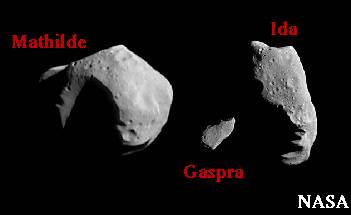 |
Between the inner and outer
planets lies the asteroid belt, also called the minor planets, composed
of thousands of rocky and iron-rich bodies ranging in size from pinhead
up to 600 miles in size. Some have rather eccentric orbits and occasionally
they collide with other bodies (like the Earth) whose orbits they cross.
When they enter the earth's atmosphere, they heat up due to friction and
they glow. These streaks of light, (shooting stars) are called meteors,
and the objects that fall to the ground are called meteorites. |
| Comets, numbering
perhaps in the trillions, are the most spectacular bodies that roam the
solar system. Mostly dirty snowballs, they are a mix of ice and dust at
most a few tens of miles in diameter. The icy material that forms the nucleus
and the more or less dense atmosphere around it, called the coma
make up the head of a comet. But the most spectacular part of a comet is
its
tail. As the comet approaches the sun, the icy materials begin
to evaporate and the gases released form the coma and string out
to make the tail (up to a hundred million miles long) that makes them so
spectacular.
Comets fall into two groups, short period comets
whose orbits lie within planetary distances, while long period comets,
(the most common) form a roughly spherical cloud that may extend outward
to trillions of miles.
As the comets circle the sun over millions and
billions of years, the ice eventually evaporates to leave only the stony
materials that still follow the original orbital path of the comet. When
these cometary fragments intersect the path of the earth, they lead to
often spectacular meteor showers, as these rocky materials burn
up in their path through the atmosphere. |
|
E. Gas and Dust
Interspersed between all of these bodies are gases
(mostly hydrogen and helium), heavier molecules, and dust. All of this
is leftover material from the original nebula that did not condense into
the larger bodies.
The Key question of course is how did a nebula
which is a cloud of gas and dust give rise to all the diverse objects in
the Solar System? |

